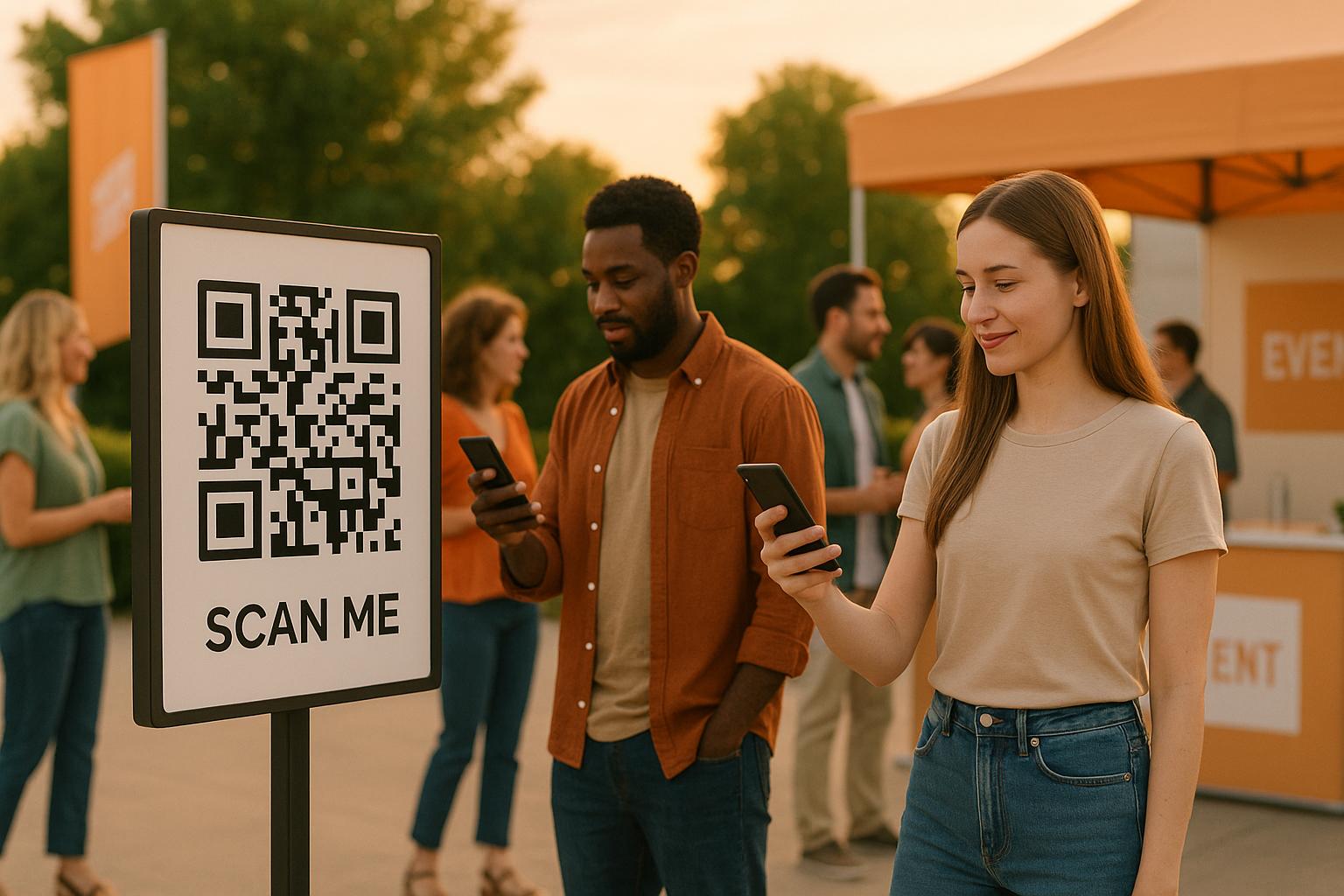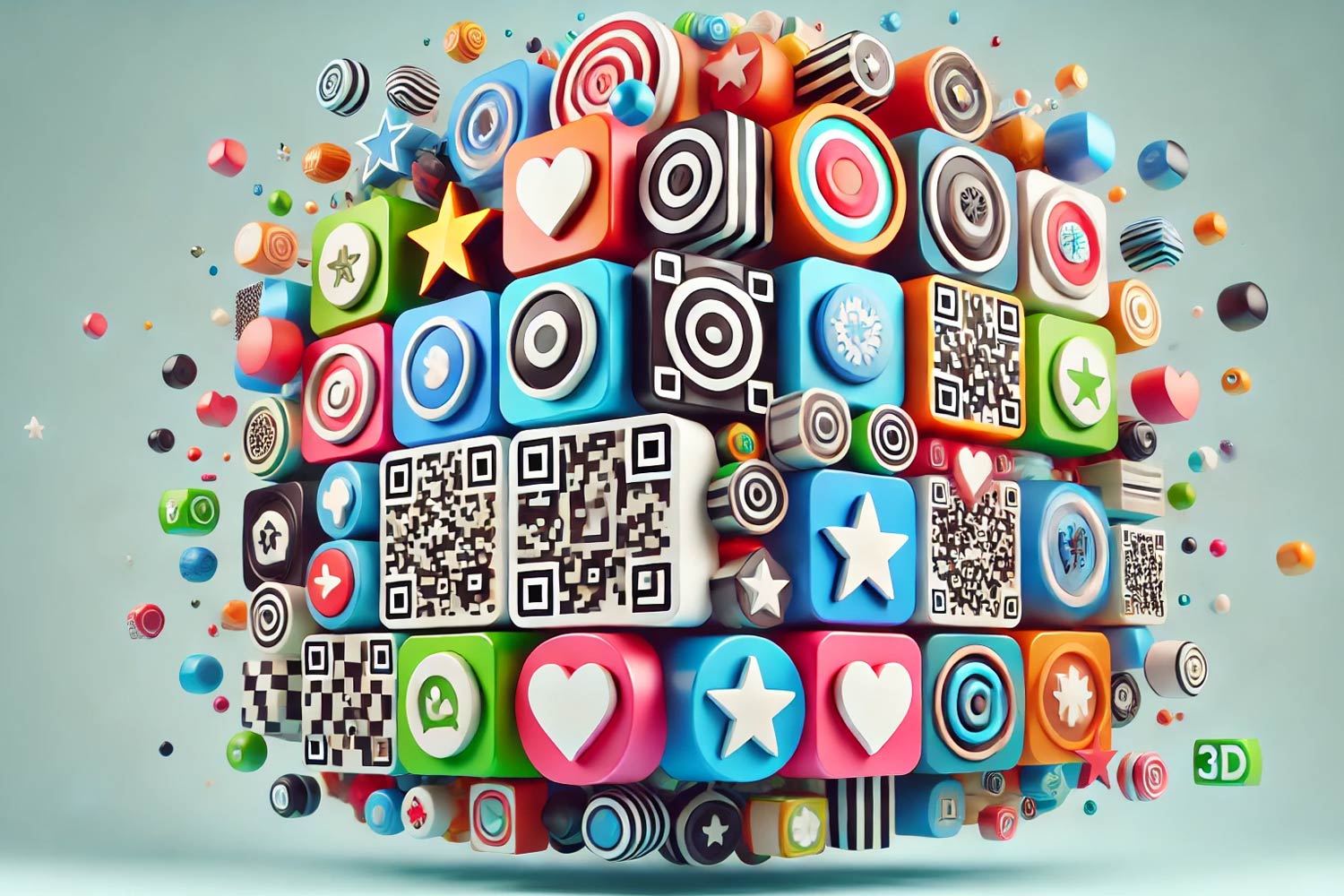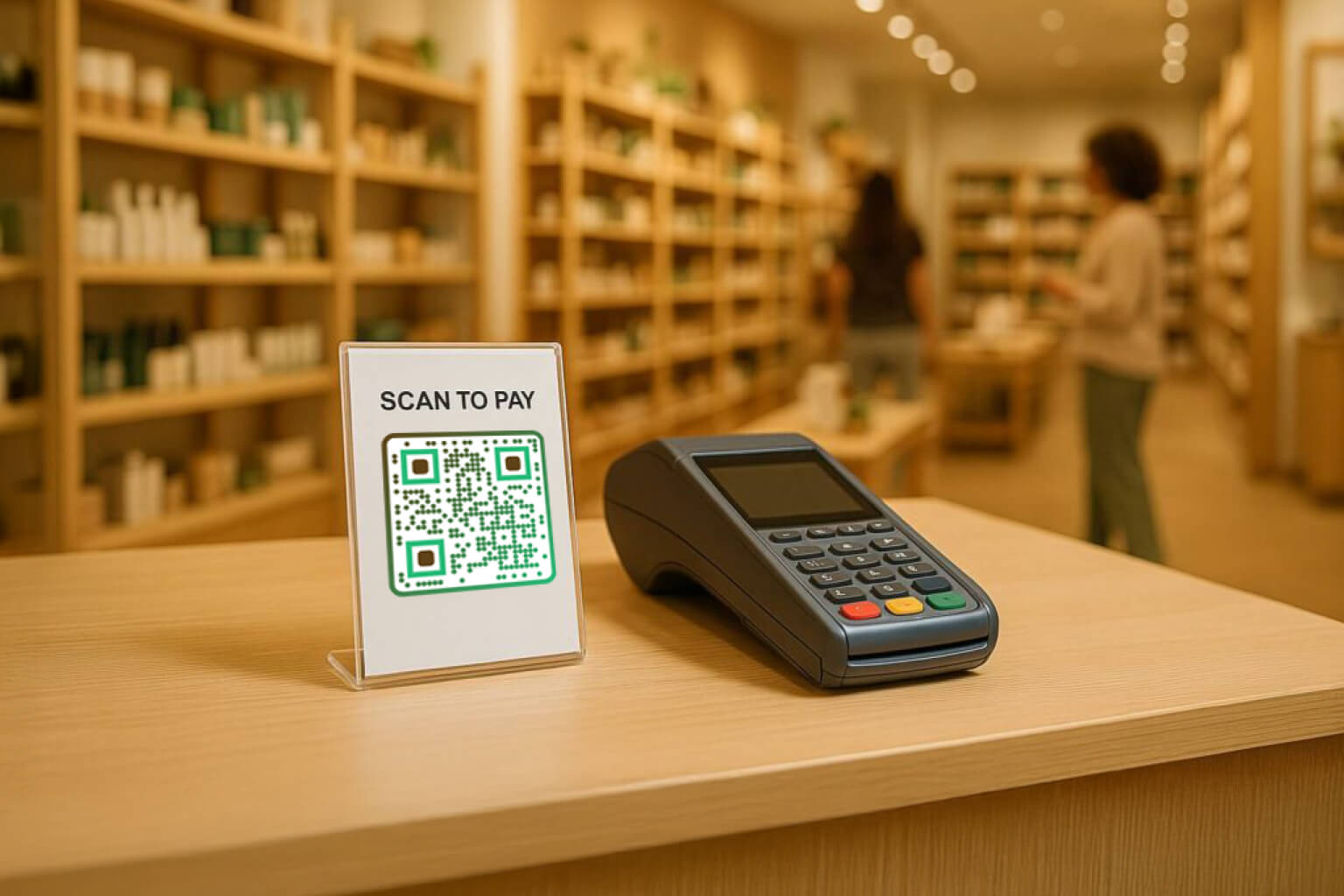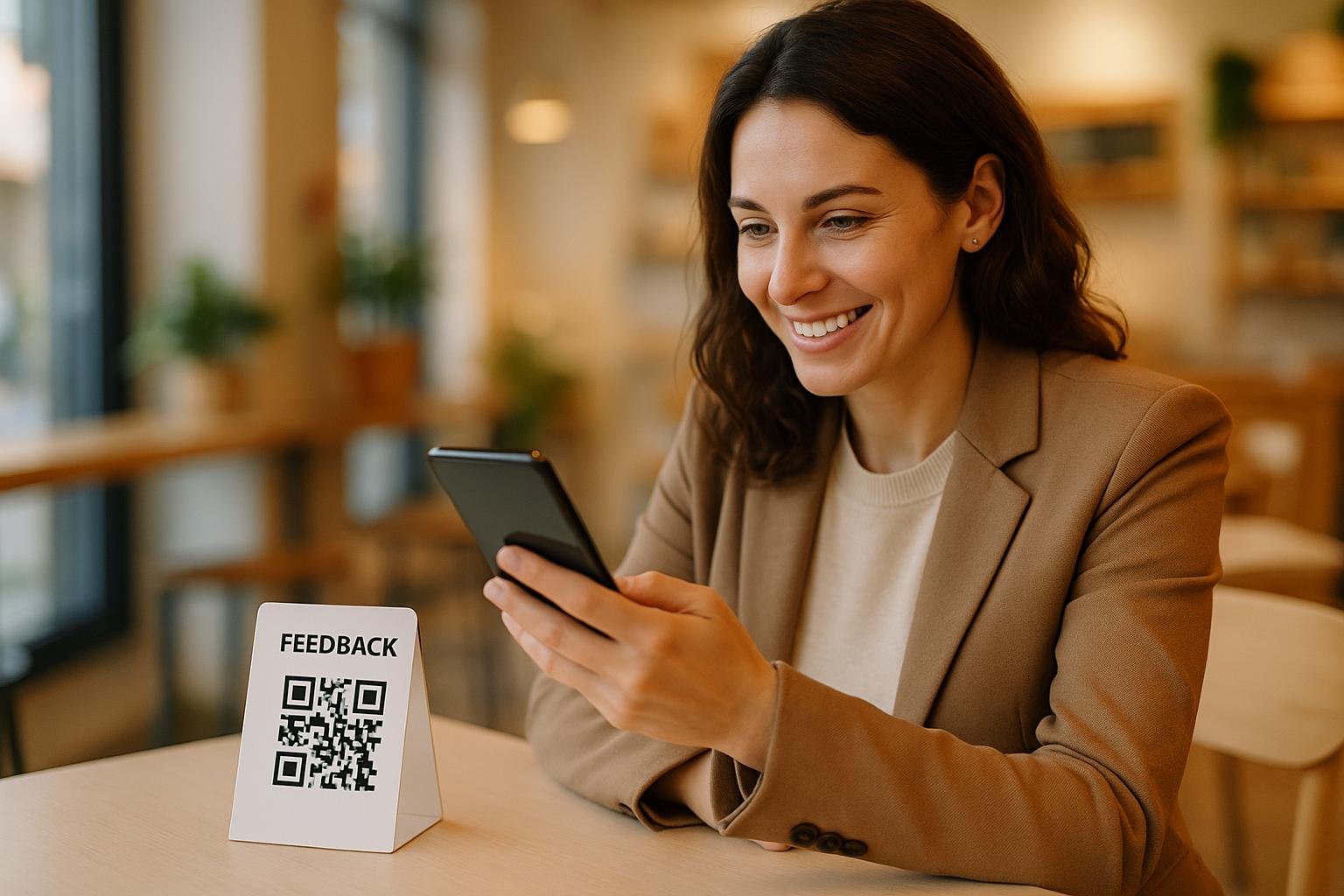QR codes are a simple yet powerful tool to connect in-person events with digital engagement. They help streamline processes like registrations, check-ins, and feedback collection while offering insights into attendee behavior. To make the most of QR codes at events:
- Before the Event: Use QR codes for early registrations, sneak peeks, and sharing logistical details.
- During the Event: Enable contactless check-ins, live updates, and interactive experiences like polls or games.
- After the Event: Collect attendee feedback, share event highlights, and promote future events.
Dynamic QR codes are especially useful, as they allow real-time updates and detailed analytics. Customizing QR codes with your brand’s colors and logo ensures they stand out and build trust. Proper placement on tickets, badges, and posters maximizes visibility and engagement. To secure your QR campaigns, test them thoroughly and use HTTPS links to protect user data.
Selecting Events and Setting Objectives

Finding the Right Events
The success of your QR code campaign hinges on choosing events where your target audience is already engaged and present. Industry conferences are a great starting point. Attendees at these events are often in a learning mindset, actively seeking new information and networking opportunities. This makes them more likely to interact with QR codes.
For B2B companies, trade shows and professional gatherings like CES or SXSW provide access to decision-makers who are comfortable using QR codes to exchange contact details or explore product information. These events are perfect for connecting with professionals who are open to digital interactions.
Seasonal holidays and celebrations also offer excellent engagement opportunities. During these times, consumer activity spikes, and people are more inclined to interact with QR codes. Whether it’s a holiday sale or a festive event, you can tap into the natural surge in consumer interest.
Local community events, such as farmers markets and neighborhood festivals, are ideal for smaller businesses. These venues usually have less competition for attention and allow for more personal interactions. The casual setting encourages attendees to scan QR codes, especially when tied to local promotions or community-focused content.
Product launches and company milestones, like store openings or anniversaries, are another great fit. These events attract audiences already interested in your brand, making them more likely to scan QR codes for exclusive content or behind-the-scenes access.
Whatever event you choose, make sure your QR code strategy aligns with the event’s theme and audience. Tailor your QR applications to provide real value, whether that’s through exclusive offers, educational content, or interactive experiences. Once you’ve picked the right events, the next step is to define clear objectives for your campaign.
Defining Campaign Goals
Setting clear and measurable goals is essential for turning your QR code campaigns into effective marketing tools. These objectives should align with your broader business goals while taking advantage of QR codes’ ability to track engagement and measure results.
For lead generation, QR codes can link directly to registration forms, contact collection pages, or newsletter signups. For example, you might set a goal like “collect 200 qualified leads” or “achieve a 15% conversion rate from scans to email signups.” These specific targets make it easier to evaluate your campaign’s success and refine future efforts.
If your focus is on brand awareness, QR codes can direct users to video content, social media profiles, or interactive experiences. A 2021 survey found that 45% of U.S. participants used a marketing QR code at least once within a three-month period, highlighting their potential for boosting exposure when used strategically.
For driving sales, QR codes work best when tied to exclusive discounts, product demos, or streamlined purchasing options. A campaign offering a limited-time deal through a QR code can encourage immediate purchases while fostering ongoing customer engagement.
Customer engagement goals might include encouraging social media interactions, sharing content, or building a sense of community. QR codes can help forge stronger connections by linking to targeted content or interactive experiences that align with your brand’s values.
Don’t overlook the power of QR codes for data collection and market research. By linking to tools like Google Forms, you can gather insights on customer preferences, event feedback, or product interest. This data can inform future campaigns and product development.
When setting objectives, think beyond the initial scan. Successful campaigns guide users through the entire customer journey, from the scan to a mobile-optimized landing page with regularly updated content. This approach ensures that your QR code campaigns not only attract attention but also maintain long-term engagement.
5 ways to use a QR code for events planning and management
Timing Your QR Code Campaigns
When it comes to QR code campaigns for events, timing is everything. Each stage of your event – before, during, and after – offers unique chances to connect with your audience. Knowing when and how to use QR codes can make a big difference in how successful your campaign turns out.
Before the Event
Using QR codes before your event helps build excitement and makes things easier for attendees before they even arrive. This phase is all about creating buzz and laying the groundwork for a smooth experience.
Streamlined Registration and Ticketing
QR codes are a perfect tool for early registration. By adding a QR code to your promotional materials, email campaigns, or social media posts, you make it easy for people to sign up with just one scan. The goal? Remove any barriers to registration and encourage quick action.
Countdowns and Sneak Peeks
Dynamic QR codes can keep your audience engaged in the weeks leading up to the event. Start with early-bird offers, then switch to updates like speaker announcements or behind-the-scenes content. This keeps the excitement alive and ensures your event stays top of mind.
Logistics Made Simple
Use QR codes to share practical details like venue maps, parking information, hotel options, or local dining spots. This helps attendees plan their trip while reducing the number of questions you’ll have to answer.
The pre-event phase usually kicks off 4–6 weeks before the big day, with activity ramping up in the final two weeks. Once the event begins, these QR strategies shift to focus on live interactions.
During the Event
The event itself is prime time for QR code engagement. Attendees are already in the zone, making them more likely to scan and interact with your content.
Contactless Check-Ins
QR codes at entry points allow for quick and hassle-free check-ins. This helps reduce wait times and keeps things moving smoothly.
Real-Time Updates
Keep attendees informed with live schedules, speaker bios, and session updates. Place QR codes in high-traffic spots like registration desks, session entrances, and dining areas, paired with clear instructions like "Scan for updates."
Networking Made Easy
QR codes on name badges or business cards can link attendees to digital profiles, LinkedIn pages, or networking platforms. This makes connecting with others effortless.
Interactive Experiences
Boost participation with live polls, Q&A sessions, or gamified activities like scavenger hunts. You can even offer prizes or exclusive content as rewards for scanning.
Incentives for Scanning
Encourage more scans by offering perks like discount codes, free downloads, or giveaways. Pair these with clear calls to action and strategic placement to maximize engagement.
Before your event kicks off, test your QR codes to make sure they work smoothly across devices and that the linked content is mobile-friendly and quick to load. Platforms like Pageloot can help you manage dynamic QR codes and track engagement in real time. Once the event wraps up, you can shift gears to focus on post-event strategies.
After the Event
The end of your event doesn’t mean the end of engagement. Post-event QR code campaigns help you stay connected with attendees and continue delivering value.
Gathering Feedback
Right after the event is the best time to collect feedback. Use QR codes to link to surveys or rating systems, and send them out via email within 24–48 hours to capture fresh insights.
Sharing Event Highlights
Extend your event’s impact by sharing photo galleries, recorded sessions, or presentation slides through QR codes. This keeps the experience alive for attendees and even reaches those who couldn’t attend.
Post-Event Offers
Use QR codes to promote early-bird deals for future events or provide exclusive content for attendees.
Ongoing Networking
Help attendees stay connected by linking QR codes to LinkedIn groups, discussion forums, or contact directories.
Access to Resources
Provide long-term value by offering QR codes that link to whitepapers, case studies, or other educational materials related to the event.
The most critical time for post-event engagement is the first week, though this phase can extend up to four weeks. Dynamic QR codes are especially useful here, as they let you update content based on attendee feedback and engagement patterns. Platforms like Pageloot make it easy to manage these codes and analyze their performance, helping you refine your strategies for future events.
sbb-itb-74874c9
Customizing and Tracking QR Codes
When it comes to running a successful QR code campaign for your event, two elements stand out: how your codes look and how well you track their performance. Nail these, and you’ll turn those little black-and-white squares into powerful tools for engagement. Miss the mark, and they might just fade into the background.
Design and Branding Options
Skip the generic QR codes – your event deserves better. By customizing your QR codes to match your event’s branding, you not only make them visually appealing but also build trust. A QR code that feels connected to your event is far more likely to get scanned.
Start with your event’s color palette. Most QR code generators let you replace the standard black with your brand colors. Just make sure there’s enough contrast for scanners to read the code without a hitch. Want to take it up a notch? Add your event logo to the center of the QR code. This simple tweak creates instant brand recognition while keeping the code fully functional.
Customization doesn’t stop there. You can play around with frames, backgrounds, and even the shape of the dots in the code. Many QR code tools offer templates designed specifically for events, making it easy to create professional-looking codes. Whether you’re placing these on business cards, posters, or flyers, a well-designed QR code will stand out.
But remember, looks aren’t everything. Test your codes across different devices and lighting conditions before printing them in bulk. A QR code that’s eye-catching but doesn’t scan reliably won’t do you any favors. Once you’ve nailed the design, focus on linking your codes to flexible, engaging content for maximum impact.
Why Use Dynamic QR Codes
Static QR codes are a one-and-done deal – they link to a fixed URL that can’t be changed. Dynamic QR codes, on the other hand, give you room to adapt. This is a game-changer for live events, where schedules and details can shift unexpectedly.
Imagine this: a keynote speaker cancels, or a session gets moved to a different room. If you’ve used static QR codes, attendees scanning them might end up with outdated information. Dynamic QR codes solve this problem by letting you update the linked content in real time. That way, everyone stays in the loop, no matter what changes.
Platforms like Pageloot make managing dynamic QR codes a breeze. You can update links and track performance from a single dashboard, giving you full control over your campaign. While dynamic codes usually come with a subscription fee, their flexibility and the data they provide often make them worth the investment – especially for complex campaigns.
Once your QR codes are both well-designed and adaptable, the next step is to measure how they’re performing. This is where analytics come into play.
Measuring Performance with Analytics
You can’t improve what you don’t measure, and QR code analytics give you the insights you need to refine your campaign. It’s not just about counting scans – it’s about understanding how, when, and where people are interacting with your codes.
For example, you can compare scan rates across different placements to figure out which locations are driving the most engagement. Time-based data might reveal that scans peak during specific sessions or ramp up in the weeks leading up to your event. Geographic information shows where your audience is located, and device type data can guide your design and placement decisions.
But the real gold lies in tracking what happens after someone scans. Did they complete a registration form? Download your event app? Share something on social media? These actions tie QR code engagement to actual results, helping you understand the true impact of your campaign.
With tools like Pageloot, you can monitor these metrics in real time. If certain QR codes aren’t performing as expected, you can quickly adjust their destinations or rethink their placement. Setting up tracking before your campaign launches is critical. Define your goals – whether it’s boosting app downloads, increasing registrations, or gathering survey responses – and use your analytics to track progress. By monitoring performance throughout your campaign, you’ll have the chance to make adjustments and improve results on the fly.
In short, combining thoughtful design with dynamic functionality and robust analytics ensures your QR code campaign doesn’t just look good – it delivers real results.
Adding QR Codes to Event Materials
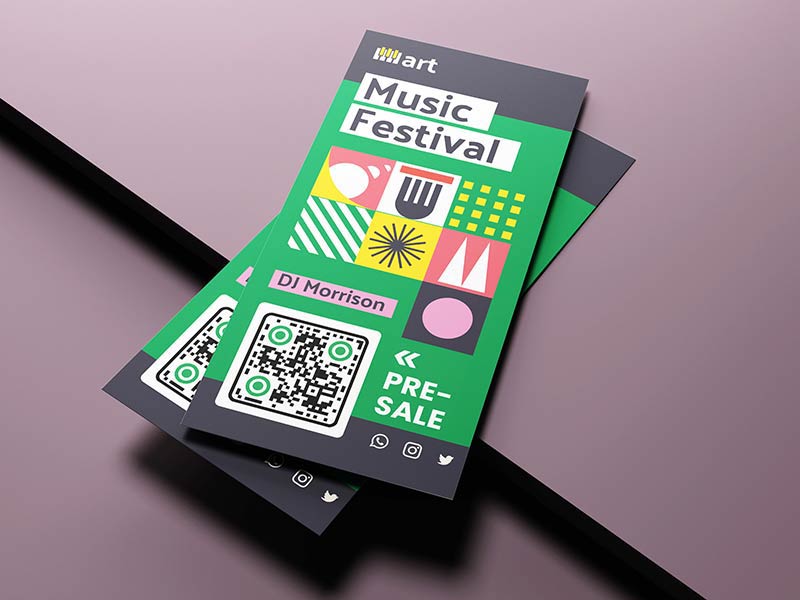 Placing QR codes strategically across event materials can make a big difference in how attendees interact with your event. The key is to ensure they’re easy to spot, simple to scan, and linked to content that adds value. Here’s how you can seamlessly incorporate QR codes into both physical and digital event materials.
Placing QR codes strategically across event materials can make a big difference in how attendees interact with your event. The key is to ensure they’re easy to spot, simple to scan, and linked to content that adds value. Here’s how you can seamlessly incorporate QR codes into both physical and digital event materials.
Print and Digital Materials
Physical materials are a perfect canvas for QR codes. For instance, adding them to event tickets is a no-brainer. Attendees already carry these, so scanning for venue maps, parking info, or schedule updates feels natural. Name badges and event programs are also excellent spots. Linking these codes to real-time digital versions helps avoid reprinting costs while keeping everyone up-to-date.
Posters and banners in high-traffic areas – like registration desks, coffee stations, or session entrances – can enhance the event experience. Picture this: a QR code on a speaker’s poster could lead attendees to their bio, social media profiles, or even a sneak peek of their presentation.
On the digital side, QR codes can extend your event’s reach. For example, email campaigns can include codes that let recipients add event details to their calendars or unlock exclusive pre-event content. Social media posts featuring QR codes can drive engagement by linking to registration pages, speaker interviews, or behind-the-scenes footage. A great example is Elle Boutique, which used a coupon QR code on promotional flyers. Customers could save the offer to their phones, share it online, and redeem it with a quick scan. This kind of integration creates multiple ways to connect with your audience.
"By strategically integrating QR codes across various touchpoints, you create a cohesive experience that encourages action and builds a sense of trust with your customers." – Adobe
These placements set the stage for even more interactive and engaging applications.
Interactive Uses
Once you’ve nailed the basics, you can use QR codes to create interactive experiences that bring your event to life. For example, contactless payments have become a must-have at food stalls, merchandise booths, and registration counters. QR codes make these transactions quick and seamless.
You can also personalize attendee experiences with unique QR codes. VIP guests might scan codes for exclusive content or priority access, while general attendees get standard event details. Some QR codes can even adapt based on scanning history, offering tailored content to repeat visitors or first-timers.
Want to make your event more engaging? Use QR codes for scavenger hunts, photo contests, or live surveys. These activities not only entertain but also encourage interaction. For instance, the band Three Sparrows used a QR code on a web banner to drive traffic to their new single, directing users to platforms like Spotify and Apple Music. Similarly, Cosmo Riders promoted their mobile game by embedding a QR code in a YouTube ad, which led viewers straight to the app store for downloads.
Security Best Practices
After integrating QR codes into your event, keeping them secure is crucial. Data protection should be a top priority. Always use HTTPS links to encrypt data transmission, ensuring sensitive information like registration or payment details stays safe.
Before rolling out your QR codes, test them on various devices to ensure they work flawlessly. Opt for a QR code generator with built-in security features and analytics to monitor scan activity for suspicious behavior. Platforms like Pageloot offer dynamic QR codes that allow real-time updates and secure management, so you can quickly disable or adjust codes if needed.
To help attendees use QR codes safely, include simple security tips in your event communications. Encourage them to verify the source of a QR code before scanning and to avoid codes from unfamiliar origins. Branding your official event QR codes and placing them in trusted locations can also go a long way in building trust.
Stay proactive by monitoring for unusual scanning patterns or reports of compromised codes. Be prepared to act quickly – disable problematic codes and notify affected attendees if necessary. Regular security audits can help you catch vulnerabilities before they escalate. And remember, keeping your QR code content updated in real time is just as important for security as it is for usability.
"QR codes let you gamify events, offer instant how-to help, or reward loyal customers – all offline and online at once." – Dumont Printing
Getting started with event QR campaigns
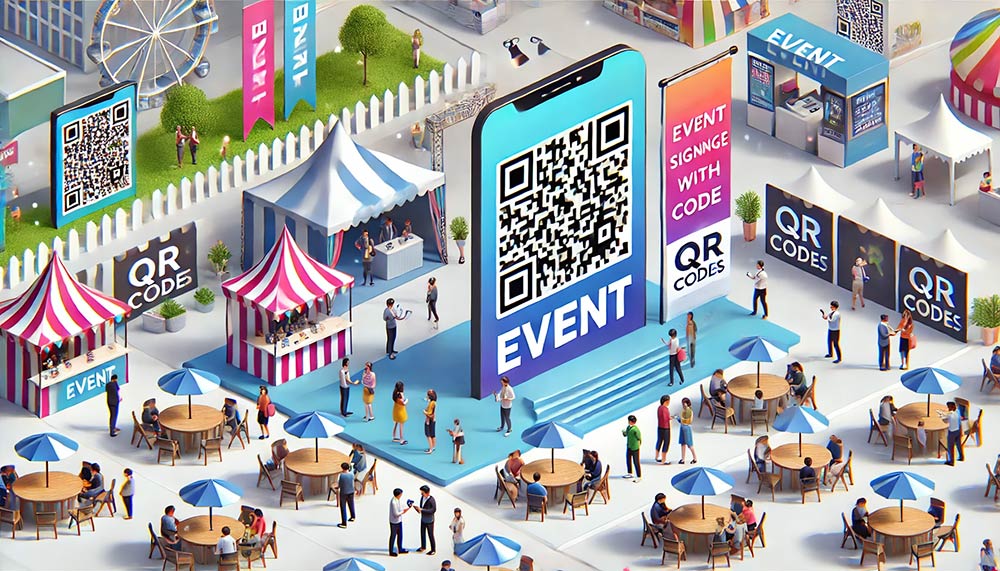 Launching an event QR campaign begins with clear goals and the right tools. Whether you’re aiming to streamline check-ins, increase social media engagement, or gather attendee feedback, start by defining your campaign’s purpose. Then, map out the attendee journey to strategically place QR codes at key touchpoints like registration emails, event tickets, and venue signage.
Launching an event QR campaign begins with clear goals and the right tools. Whether you’re aiming to streamline check-ins, increase social media engagement, or gather attendee feedback, start by defining your campaign’s purpose. Then, map out the attendee journey to strategically place QR codes at key touchpoints like registration emails, event tickets, and venue signage.
Dynamic QR codes are a must. They let you update content even after printing and provide access to real-time analytics. This flexibility ensures your campaign stays relevant and effective.
Once you’ve set up a dynamic system, focus on making your QR codes visually appealing. Customization is key – incorporate your brand’s colors, logos, and unique designs to make the codes stand out. This not only enhances their look but also increases scan rates and user trust. You can easily create a QR code tailored to your event.
Pageloot offers an intuitive platform with over 25 types of QR codes, advanced design options, and real-time analytics. You can even make last-minute updates without the hassle of reprinting materials.
Before rolling out your campaign, test your QR codes under different conditions – across devices and in various lighting – to ensure they work seamlessly. Position them in high-traffic areas like registration desks or coffee stations for maximum visibility and engagement[2].
As your event unfolds, use real-time analytics to monitor performance. Track scan rates, peak usage times, and user behavior to gather insights that can improve future campaigns. Start small by focusing on one or two touchpoints, like registration or feedback collection, and expand as you gain confidence and data.
When you’re ready to launch, consider trying Pageloot’s free QR generator. Test static codes at no cost, and when you’re ready for advanced features like dynamic updates and in-depth analytics, you can upgrade to unlock more possibilities.
FAQs
How can I make my QR code campaign relevant to the event and its audience?
To make your QR code campaign stand out at an event, start by aligning the QR code design with the event’s branding, colors, and overall theme. This not only reinforces the event’s identity but also creates a polished and cohesive experience for attendees. Make sure the linked content – like landing pages or promotional materials – is tailored to the event’s goals and resonates with the audience’s interests.
Leveraging dynamic QR codes can bring added flexibility. These codes let you update the linked content in real time, making it easy to adapt to different activities or segments during the event. You can also enhance the experience by integrating features like contactless payments, event check-ins, or even personalized messages. By understanding your audience’s preferences and aligning your campaign with their expectations, you can significantly boost engagement and leave a lasting impression.
What makes dynamic QR codes better than static ones for event campaigns?
Dynamic QR codes have transformed event campaigns by offering the ability to update linked content or destinations without needing to reprint the code. This feature is especially useful for events where details like schedules, venues, or special offers might shift at the last minute.
On top of that, they offer robust tracking capabilities. With dynamic QR codes, you can access detailed analytics – think scan rates, user locations, and device types. This data not only helps gauge engagement but also provides valuable insights to fine-tune future campaigns. Their flexibility and data-driven approach make them a smart choice for events requiring real-time updates and measurable impact.
How can I track and evaluate the success of my QR code campaign during and after an event?
To gauge how well your QR code campaign is performing, leverage real-time analytics to track important metrics like the number of scans, user locations, and the types of devices being used during the event. This immediate feedback helps you see how effectively your QR codes are connecting with your audience as things unfold.
Once the event wraps up, dive into data like total scans, unique users, and engagement patterns to evaluate the campaign’s overall success. By syncing QR code analytics with your other marketing tools, you can also analyze conversions and ROI, giving you a comprehensive view of your campaign’s impact.

